The live animal trade is immense, and a common source of invasive wildlife, and even disease. From 2000 through 2006 some 1.48 billion live animals –an average of 600,000 per day– were legally imported into the United States. For perspective, the United States had 69.6 million international visitors in 2013, just 1/20th of the number of imported animals.
Burmese Python
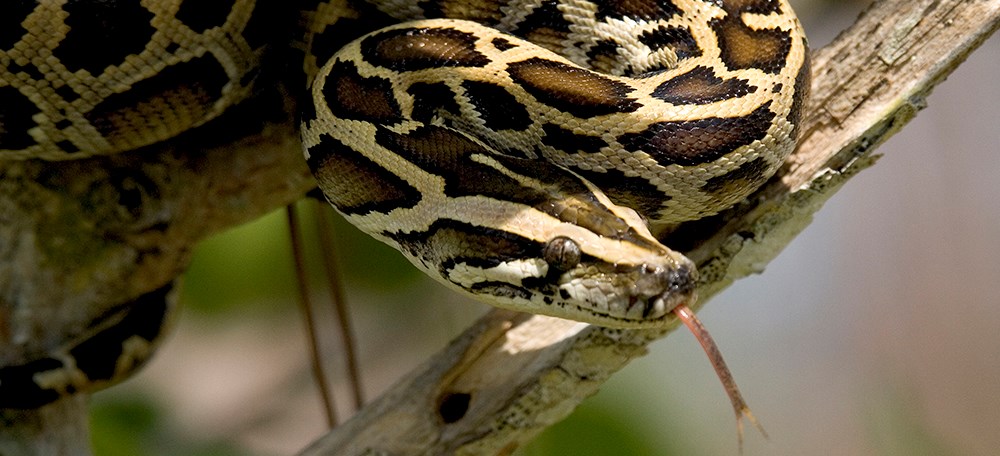
Nearly 10,000 Burmese pythons were imported annually between 1996 and 2006. The Burmese python was probably both intentionally released and escaped into the wild in Florida. In the 15 years since it was first known to have become established in the wild, its population has exploded in southern Florida to an estimated 100,000 snakes and the cost of control is estimated to be about $720,000 annually. The species has devastated native populations of raccoon, opossum, fox, rabbits, and even deer. Only after they were established in the wild was their importation prohibited, but there is no known way to control or eradicate them in the wild.
Nutria
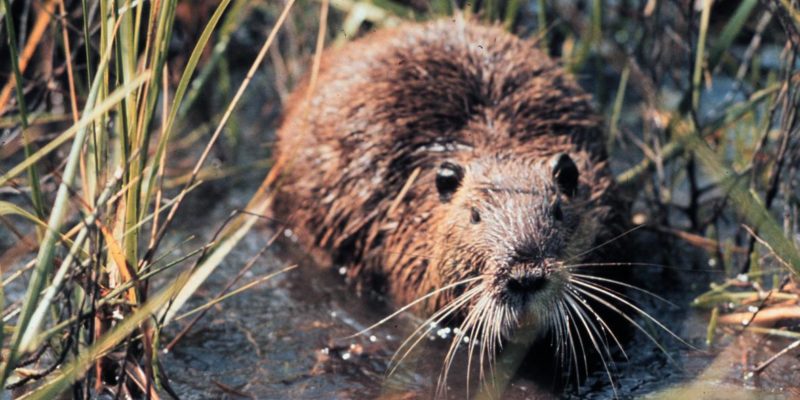
Nutria are raccoon-sized rodents that live along stretches of water and devour aquatic plants. In the late 19th early 20th centuries, fur farmers brought nutria from South America to the United States to farm and sell their once-valuable pelts. Across several regions in the United States, nutria escaped from the farms or were released once demand for fur crashed and the farms were no longer profitable. Nutria are now wreaking havoc on wetlands across the Southeast, Pacific Northwest, Mid-Atlantic, and smaller patches elsewhere. Rather than just eating leaves, nutria voraciously feed on entire marsh plants, including their roots, rhizomes, tubers, and young shoots. This makes it harder for the plants to grow back and causes significant erosion and damage to wetlands. In the Chesapeake Bay, nutria have caused the loss of tens of thousands of acres of marsh to erosion. Controlling nutria is challenging because they are highly prolific breeders. Nutria breed year-round and can give birth to two to three litters of four to nine young each year. However, the successful eradication of nutria from England demonstrates that eliminating them is possible, and a number of nutria eradication programs are underway and have shown success in the United States.
Wooden pallets and wooden crates have been widely used for the international transport of goods. Unfortunately, absent proper treatment or the use of alternative materials, wood-boring insects such as the emerald ash borer (Agrilus planipennis) and Asian longhorned beetle (Anoplophora glabripennis) have found their way to the United States.
Emerald Ash Borer
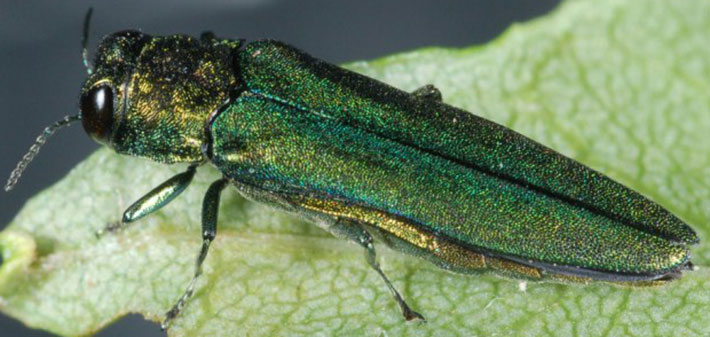
The emerald ash borer is a non-native, invasive beetle whose larvae kill ash trees by burrowing underneath the bark and destroying the tree’s circulatory system. The beetle was first detected near Detroit in 2002 – although it was probably present for 10 years before its discovery. The emerald ash borer likely traveled to the United States on solid wood packing material shipped from its native Asia. Since its initial establishment in Michigan, recreational and commercial movement of infested firewood has further spread emerald ash borer unintentionally. It is now found in 35 states and 5 Canadian provinces and is estimated to have killed hundreds of millions of ash trees. The decimation of ash trees has led to huge financial losses for businesses, property owners, municipalities, and state agencies who have been forced to treat or remove infested trees and limit the sale and transport of ash products. Ash trees are also an important canopy species whose seeds provide valuable food for wildlife.
Despite the large area that EAB has invaded, the area represents only about a quarter of all forests with ash trees in the U.S. Some areas with significant ash populations where EAB is still absent include North Dakota’s riparian areas, and the full native range of Oregon ash – from Washington’s Puget Sound south to central California. Forests in the southwestern USA and Mexico also contain many endemic species of ash trees that are not yet invaded by this insect.
The beetle has been one of the foundational species of a nation-wide educational program urging people not to transport firewood. To learn more, visit dontmovefirewood.org, and remember: buy it where you burn it!
Asian Longhorned Beetle
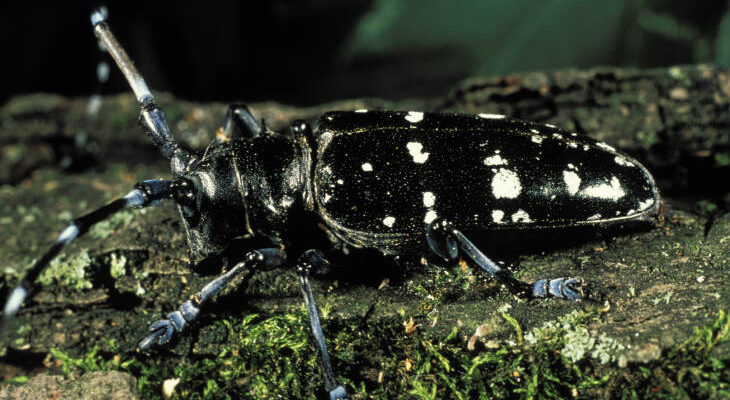
The Asian longhorned beetle kills dozens of tree species from 15 plant families, especially maples, elms, and willows. Forests dominated by vulnerable species make up more than 10% of all U.S. forests, especially those stretching across the North from Maine to Minnesota, and the majority of Canada’s hardwood forests. Many cities’ trees – in yards and parks and lining the streets – are susceptible to Asian longhorned beetle.
The Asian longhorned beetle has been introduced to North America and Europe at least 16 times in wooden crates and pallets, with the majority of the introductions likely occurring in the late 1980s through the 1990s. A determined campaign spanning more than 20 years by the U.S. Department of Agriculture, state and municipal agencies, and Canadian federal agencies has eradicated all but three of the known outbreaks as of January 2020. Asian longhorned beetle infestations are still present in parts of New York, Massachusetts, and Ohio. As of 2018, eradication programs in the United States had necessitated the removal of more than 180,000 trees. Wood boring beetles continue to be detected in solid wood packaging – so there remains a risk that the Asian longhorned beetle will be introduced again.
The intentional importation of plants and animals for commercial purposes poses many risks. The aquarium trade has facilitated the spread of several invasive fish and aquatic plants, while the nursery stock has transmitted plant diseases.
Lionfish
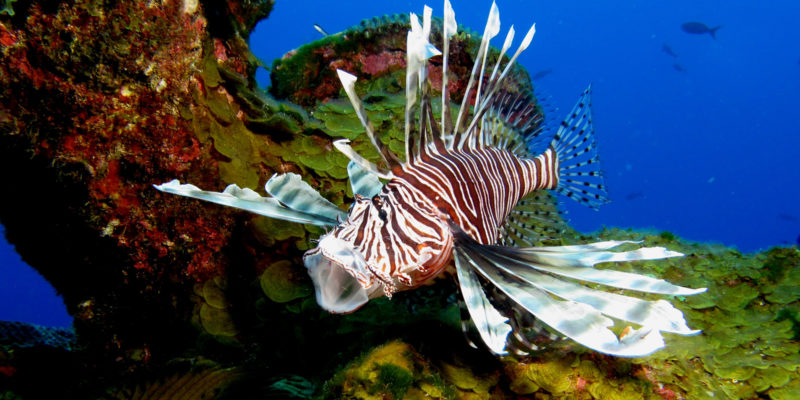
The bright colors and flashy fins of the lionfish may look visually captivating, but their venomous spines and damaging habits in their non-native range reveal a more sinister fish. Two visually identical species of lionfish have invaded the United States’ coastal waters: the red lionfish and the fire devilfish. Originally from the Pacific and Indian oceans, lionfish have been introduced into the north-west Atlantic Ocean, Caribbean Sea, and the Gulf of Mexico. Nobody knows for sure how lionfish entered the coastal waters of the U.S., but being popular aquarium fishes, the most probable explanation is that they arrived via the aquarium trade and may have been released as pets. True to their name, lionfish are voracious predators and have devastated coral-reef fish communities in their non-native range. A study from 2008 found that the accumulation of new juvenile reef fish in the Bahamas was reduced by 79% on reef patches with just one lionfish compared to reefs with no lionfish. By reducing the abundance of ecologically important fish like parrotfish, which consume algae that would otherwise smother corals, and competing with native predatory fish for resources, lionfish can have broad impacts on entire coral-reef ecosystems. Without increased regulation and oversight, the aquarium trade all but guarantees that more ecologically destructive invasive fish like the lionfish will become established in our waters.
Hyrdilla
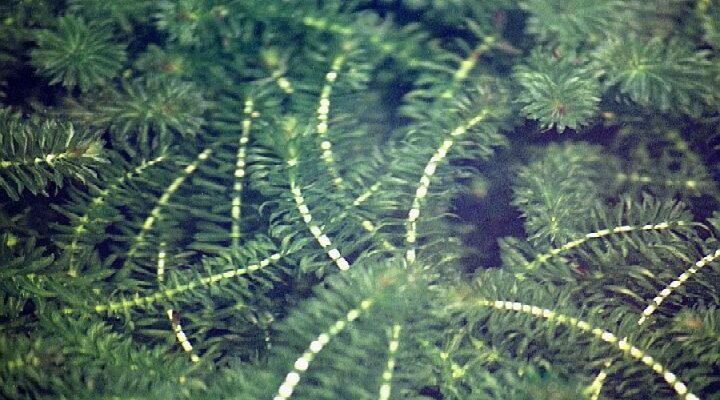
This freshwater plant was intentionally brought into the United States for use in the aquarium trade. A few fragments of the plant escaped, and now the plant is well established. Hydrilla has been found primarily in the southeastern states. It covers the entire surface of waterways, affecting their entire ecology by choking out other plants, reducing sunlight in the water, and secondarily affecting fish and wildlife.
Sudden Oak Death
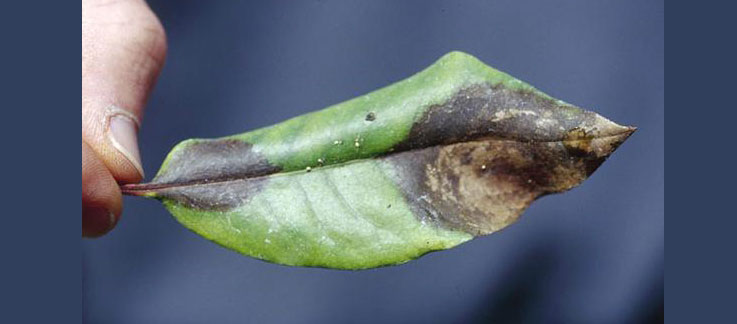
Sudden oak death has killed more than 50 million trees in California and Oregon since it was introduced to central California, likely in the late 1980s. It probably entered the country on imported woody plants. Since its introduction, sudden oak death has spread to a region reaching from southern Oregon to central California. The pathogen infects a wide variety of plants including tanoak, several true oaks, some conifers, and many others. In some parts of the affected area, nearly all woody species can be infected. In Oregon, a second genetic strain of the pathogen has become established in the forest; scientists worry that it will prove even more damaging.
Many of the plants that can become infected are favorites in ornamental horticulture, and as a result, sudden oak death is sometimes transported to uninfested areas by shipments of nursery stock. One such case occurred in 2019, when plants exposed to the pathogen were sent to 18 states – Alabama, Arkansas, Iowa, Illinois, Indiana, Kansas, Kentucky, Michigan, Missouri, Nebraska, North Carolina, Ohio, Oklahoma, Pennsylvania, Tennessee, Texas, Virginia, and West Virginia. If the pathogen is spread to the eastern states, numerous species might become infected, including several oaks, rhododendrons, and mountain laurel.
Scientists have discovered related microbes in Southeast Asia, Taiwan, parts of China, and Chile. Some of these, if introduced to the United States on plant imports, might prove as damaging as sudden oak death.
Ballast water is water taken into a ship’s hold to increase maneuverability and stability while in transit. It is often then discharged, hundreds if not thousands of miles from where the water was taken up. Ballast water has transported many organisms from their natural ranges to other areas throughout the world. Although some standards have been developed to reduce the transport of species via ballast water, it continues to be a problem in many areas.
Zebra Mussel
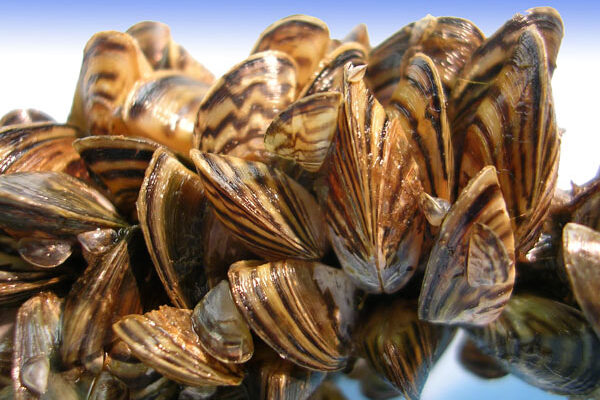
This freshwater mussel was first found in the Great Lakes in 1988 and rapidly spread throughout the Great Lakes Basin and then into the Mississippi River Drainage. Widely believed to have been brought in by ballast water, it can rapidly block intake and discharge pipes due to its massive numbers and growth. The effect on aquatic ecosystems is profound. These filter feeders greatly reduce the phytoplankton and zooplankton communities, with a likely impact on populations of fish that depend on plankton, as well as fish further up the food chain.
Stony Coral Tissue Loss Disease
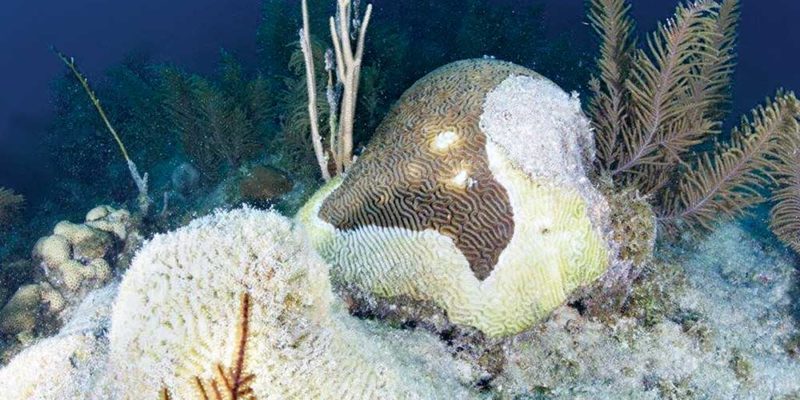
One geography that is particularly vulnerable to the effects of ballast water is Florida, where coral reefs and other important aquatic ecosystems exist in close proximity to shipping lanes and shoreside shipping facilities. Florida has 15 ports that are visited by large commercial vessels that carry, as a routine part of operations, large volumes of ballast water. Five of these ports fall within south Florida where an unprecedented water-borne coral disease outbreak, Stony Coral Tissue Loss Disease (SCTLD), has been underway since 2014.
Florida’s coral reefs support more than $7 billion in economic activity, protect billions more in property from storm-related flooding, and support tens of thousands of jobs in the tourism and fishing industries that are economic engines for much of south Florida’s economy. SCTLD is lethal to more than half of Florida’s reef-building coral species and has moved quickly through most of Florida’s main reef tract, from Fort Pierce to Key West. While the exact pathogen(s) remain unknown, there is evidence of bacterial and viral co-infections and the transmissibility in water is well-documented.
